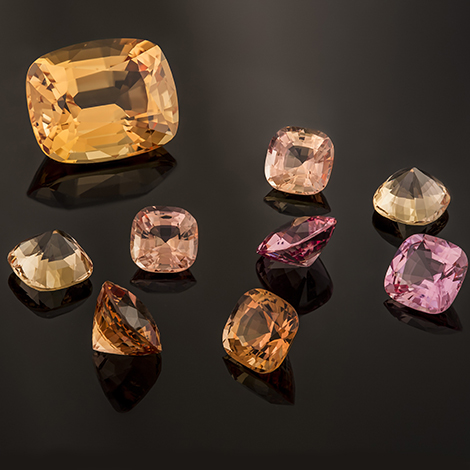 Menu
Menu

Hardness (or Mohs Hardness) : 8
RI (Refractive Index) : 1.619 to 1.627 with birefringence from 0.008 to 0.010
SG (Specific Gravity) : 3.53 to 3.56
| Dimensions in mm | Carat |
| 2,0 | 0,04 |
| 2,5 | 0,08 |
| 3,0 | 0,13 |
| 3,5 | 0,19 |
| 4,0 | 0,33 |
| 4,5 | 0,40 |
| 5,0 | 0,59 |
| 5,5 | 0,75 |
| 6,0 | 0,98 |
| 7,0 | 1,87 |
| Dimensions in mm | Carat |
| 4x3 | 0,17 |
| 5x3 | 0,27 |
| 6x4 | 0,55 |
| 7x5 | 0,94 |
| 8x6 | 1,39 |
| 9x7 | 2,10 |
| 10x8 | 2,94 |
| 11x9 | 4,11 |
| 12x10 | 5,13 |
| 14x10 | 6,16 |
| Dimensions in mm | Carat |
| 4x2 | 0,11 |
| 5x2,5 | 0,20 |
| 6x3 | 0,31 |
| 8x4 | 0,68 |
| 10x5 | 1,31 |
| 12x6 | 1,98 |
| 15x7 | 3,78 |
| 16x8 | 4,50 |
| 18x9 | 6,73 |
| 20x10 | 9,78 |
| Dimensions in mm | Carat |
| 3,0 | 0,11 |
| 4,0 | 0,24 |
| 4,5 | 0,43 |
| 5,0 | 0,52 |
| 5,5 | 0,73 |
| 6,0 | 0,87 |
| 7,0 | 1,40 |
| 8,0 | 1,99 |
| 9,0 | 2,74 |
| 10,0 | 4,07 |
| Dimensions in mm | Carat |
| 4x3 | 0,24 |
| 5x3 | 0,32 |
| 6x4 | 0,40 |
| 7x5 | 1,34 |
| 8x6 | 1,96 |
| 9x7 | 2,85 |
| 10x8 | 4,35 |
| 11x9 | 5,94 |
| 12x10 | 7,35 |
| 14x10 | 7,56 |
| Dimensions in mm | Carat |
| 5x3 | 0,23 |
| 6x4 | 0,45 |
| 7x5 | 0,79 |
| 8x5 | 1,00 |
| 9x6 | 1,60 |
| 10x7 | 2,18 |
| 12x8 | 3,50 |
| 14x9 | 4,92 |
| 15x10 | 6,41 |
| 16x12 | 9,44 |
| Dimensions in mm | Carat |
| 2,0 | 0,05 |
| 2,5 | 0,09 |
| 3,0 | 0,19 |
| 3,5 | 0,25 |
| 4,0 | 0,39 |
| 4,5 | 0,60 |
| 5,0 | 0,71 |
| 5,5 | 0,85 |
| 6,0 | 1,27 |
| 7,0 | 2,07 |
The main topaz deposits are in Brazil, but very nice topazes can also be found in Madagascar, Myanmar, Mexico, Nigeria, Pakistan, Russia, Sri Lanka and Zimbabwe.
-Heat treatment: most pink topazes are actually heated yellow topazes.
-Irradiation: artificial irradiation will completely change the colour of a topaz to very attractive green, orange, pink or intense yellow shades.
The resulting color is not stable and fades upon exposure to light.
-Irradiation followed by annealing (heat-treatment to stabilise the resulting colour):
most blue topazes on the market are actually very pale blue gemstones turned into “swiss blue” or “london blue” thanks to this stable treatment.
- Diffusion: a stable treatment that turns average pale topazes into attractive green ones.
- Coating: some colorless or very pale topazes can be coated with metal oxides to create the appearance of very colourful gems, or a special effect like in a “mystic” topaz.
- Do not leave the topaz under a strong light as the colour may fade.
- Working on topaz requires lots of care as its cleavage can be tricky.
- Be very careful when using ultrasound and steam jets
- Thermal shocks should be avoided
- Impacts should also be avoided as it might break the stone
- Keep away from acidic substances as well.